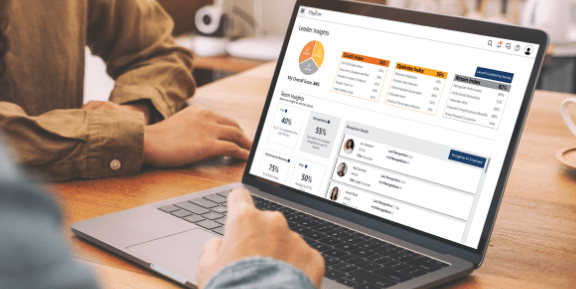HR Predictive analytics takes your historical workforce data and uses statistical models to forecast what’s likely to happen next. It’s like having a crystal ball for your HR decisions, except instead of magic, it’s powered by math and pattern recognition.
What Is HR Predictive Analytics?
HR Predictive analytics takes your historical workforce data and uses statistical models to forecast what’s likely to happen next. It’s like having a crystal ball for your HR decisions, except instead of magic, it’s powered by math and pattern recognition.
Traditional HR reporting tells you what already happened—your turnover rate was 15% last year, or you took an average of 45 days to fill open positions. That’s useful for understanding where you’ve been, but it doesn’t help you prepare for where you’re going.
Predictive HR analytics flips that script. Instead of just knowing that Sarah from accounting quit last month, you might learn that employees like Sarah, with her tenure, performance profile, and recent engagement scores, have a 73% chance of leaving within six months. Now you can do something about it while Sarah’s still at her desk.
The difference is profound. You’re moving from autopsy to prevention, from reactive to proactive. Instead of conducting exit interviews after good people leave, you’re having retention conversations while they’re still invested in staying.
Why Is HR Predictive Analytics Important for HR Leaders?
Let’s be honest, HR has an image problem. Too many business leaders still see HR as the department that handles paperwork and organizes company picnics. HR Predictive analytics changes that conversation entirely.
When you can walk into a leadership meeting and say, “Based on our analysis, we’re likely to lose 12 high-performing engineers in the next quarter unless we address compensation gaps,” you’re not just reporting problems — you’re providing strategic intelligence. That’s the kind of insight that gets attention from the C-suite.
But it goes deeper than just looking impressive in meetings. The business world is moving faster than ever, and the cost of people mistakes keeps climbing. When a key employee quits unexpectedly, you’re not just dealing with recruitment costs, you’re also managing knowledge loss, team disruption, and often customer impact.
Consider what happens when you hire wrong. Beyond the obvious costs of recruiting and training a replacement, there’s the productivity loss, the impact on team morale, and the opportunity cost of not having the right person in that role. Some studies put the total cost of a bad hire at 2-3 times the person’s annual salary.
Now imagine you could reduce those mistakes by even 20%. The ROI for predictive HR analytics becomes compelling pretty quickly.
Benefits of Using Predictive Analytics in Human Resources
Predictive analytics is changing how HR teams make decisions, moving them from guesswork and gut feelings to something a lot closer to science. Instead of reacting to problems after they’ve already caused headaches, companies can now spot trouble early, find hidden opportunities, and make smarter bets on their people. Here’s how predictive analytics is helping HR departments get real results where it matters most.
Stopping the Revolving Door
The most immediate payoff is usually in retention. When you can identify employees who are likely to leave — and more importantly, understand why they’re thinking about leaving — you can intervene before they start updating their LinkedIn profiles.
This isn’t just about saving recruitment costs, though that’s certainly part of it. It’s about preserving institutional knowledge, maintaining team stability, and protecting customer relationships. When your best salesperson or your most-skilled developer gives notice, the damage often extends far beyond the immediate replacement costs.
Hiring People Who Actually Succeed
Most hiring is still based on gut feelings dressed up as professional judgment. HR Predictive analytics lets you identify the characteristics that actually help predict success in your specific environment, not just what worked at other companies or what seems logical on paper.
Maybe your most successful customer service reps don’t have extensive experience, but they might have certain personality traits and communication styles that you can now identify in candidates. Or perhaps your top engineers share educational backgrounds or problem-solving approaches that aren’t obvious from traditional interviews.
Planning Before Problems Hit
Traditional workforce planning is often little more than educated guessing. How many people will we need next year? What skills will be most important? When will current employees be ready for promotion? Predictive analytics turns these questions from guesswork into forecasting.
This is especially valuable in fast-changing industries where skills become obsolete quickly. Instead of scrambling to find cybersecurity experts after a breach, you can predict demand and start developing those capabilities internally.
Getting More from Your People Investment
Employee development is expensive, and most organizations don’t have great data on what actually works. Predictive analytics can identify which training programs, mentorship arrangements, or development experiences actually lead to better performance and career progression.
You might discover that employees who complete certain certifications are more likely to get promoted, or that people who work on cross-functional projects show higher engagement scores. This lets you invest development resources where they’ll have the biggest impact.
Making Benefits Actually Beneficial
Most benefits packages are built on assumptions about what employees value. HR Predictive analytics can show you which benefits actually drive retention and satisfaction for different employee segments. Maybe flexible work arrangements matter more than additional vacation days for your tech team, or professional development budgets have bigger impact than salary bumps for your high-potential employees.
Use Cases for HR Predictive Analytics
Predictive analytics in HR is showing up in real situations with measurable impact. From forecasting turnover to pinpointing the best candidates and optimizing training investments, companies are finding all sorts of creative ways to put their data to work. Here are a few examples of how predictive HR analytics is actually being used.
Talent Acquisition That Actually Works
Stop hiring based on hope and start hiring based on data. When you analyze your best performers — not just who gets good reviews, but who actually drives business results — you can identify patterns that predict success.
This goes beyond the obvious of education and experience. Maybe your top salespeople share certain personality traits, or your best managers have specific types of leadership experience. Once you know what to look for, you can screen candidates more effectively and make better hiring decisions.
Paycor’s talent acquisition solutions help you track these patterns and apply predictive insights throughout your hiring process. The goal isn’t to replace human judgment, but to give your instincts better data to work with.
Workforce Management That Thinks Ahead
If you’re managing hourly workers, seasonal staff, or complex scheduling requirements, HR predictive analytics can be a game-changer. Instead of reacting to staffing shortages or overstaffing situations, you can forecast needs based on historical patterns, business projections, and even external factors such as weather or economic conditions.
Our workforce management platform incorporates predictive capabilities that help you optimize scheduling, reduce overtime costs, and maintain service levels. The system can even predict which employees are most likely to accept overtime or call in sick, making your planning more accurate.
Retention Before It’s Too Late
This is probably the most popular use case, and for good reason. Employee flight risk models analyze patterns in behavior, performance, and engagement to identify people who might be considering leaving. The key is getting enough advance warning to actually do something about it.
The signals aren’t always obvious. Maybe it’s employees who haven’t had a career development conversation in six months, or people whose manager relationships have changed, or workers who’ve stopped participating in optional training. The patterns are often subtle, but they’re there if you know how to look.
Performance Management That Actually Predicts Performance
Traditional performance reviews are mostly backward-looking. Predictive analytics lets you identify the factors that actually drive high performance in your organization, then help other employees develop those characteristics.
You might discover that employees who receive regular coaching perform better, or that people with certain skill combinations excel in specific roles. This information helps you make better development investments and internal mobility decisions.
Benefits and Compensation Strategy
Most organizations make benefits decisions based on industry benchmarks or employee surveys. Predictive HR analytics can show you which benefits actually drive retention and satisfaction for different employee segments. This lets you optimize your total rewards package for maximum impact rather than just following what other companies do.
Strategic Workforce Planning
Instead of extrapolating from past trends, you can model different scenarios and predict how changes in business strategy, market conditions, or organizational structure will affect your workforce needs. This is particularly valuable for organizations experiencing rapid growth or operating in volatile markets.
Examples of Predictive Analytics in HR
HR teams are already using these tools to tackle some of their biggest challenges, from keeping top talent to hiring more effectively. Here are a couple of real-world examples that show predictive HR analytics in action on the people side of business.
Employee Retention Modeling
One of the most common applications involves building models to identify employees at risk of leaving. This typically starts with analyzing historical turnover data to identify patterns that preceded departures. The analysis might reveal that employees who haven’t had career development conversations in six months, or those whose manager relationships have changed, or workers who’ve stopped participating in optional training show higher likelihood of leaving.
The key indicators often vary by role and industry. For technical roles, it might be employees who haven’t worked on challenging projects recently or those who’ve expressed interest in new technologies but haven’t received training opportunities. For customer-facing roles, it might be people whose customer satisfaction scores have declined or who’ve had conflicts with difficult clients.
The predictive model assigns risk scores to employees and flags those who might be considering leaving. This gives HR and managers time to have meaningful conversations and address underlying issues before employees start looking elsewhere.
Hiring Success Prediction
Another powerful application involves analyzing your best performers to identify the characteristics that predict success in your specific environment. This goes beyond traditional qualifications to examine personality traits, problem-solving approaches, educational backgrounds, and even interview performance patterns.
The analysis might reveal that your top performers share certain characteristics that aren’t obvious from resumes or interviews. Maybe successful employees in technical roles demonstrate specific types of problem-solving skills, or high-performing managers have particular leadership experiences or communication styles.
This information helps improve hiring decisions by identifying what to look for in candidates. Instead of relying on generic job requirements or gut feelings, you can screen for the characteristics that actually predict success in your organization. The result is often improved hiring success rates and reduced time-to-productivity for new employees.
How Paycor Helps with HR Predictive Analytics
Most HR teams know they should be using HR predictive analytics, but they’re not sure how to get started. The data is scattered across multiple systems, the tools seem complicated, and honestly, many HR professionals didn’t sign up to become data scientists.
That’s where Paycor’s intelligent HCM platform comes in. We handle the complex data integration and analytical heavy lifting so you can focus on what you do best — understanding and developing your people.
Everything in One Place
The biggest barrier to predictive HR analytics is usually data quality and integration. When employee information is scattered across payroll, benefits, performance management, and time tracking systems, it’s nearly impossible to get the complete picture needed for accurate predictions.
Paycor’s platform captures comprehensive workforce data throughout the employee lifecycle. From recruitment and onboarding through performance management and succession planning, everything flows through a single integrated system. This eliminates data silos and gives you the rich dataset that predictive analytics requires.
Analytics That Actually Make Sense
Our analytics capabilities are designed for HR professionals, not statisticians. You don’t need to understand regression analysis or machine learning algorithms to get actionable insights about your workforce.
The platform includes predictive models for common HR challenges: identifying flight risks, optimizing hiring decisions, forecasting workforce needs. But it’s also flexible enough to support custom analysis as your capabilities and confidence grow.
Insights That Drive Action
The goal isn’t just to predict what might happen; It’s to know what to do about it. When the system identifies employees at risk of leaving, it suggests specific retention strategies based on what’s worked for similar employees in the past. When hiring analytics show that certain candidate characteristics predict success, you can adjust your recruitment approach accordingly.
This integration between insight and action is what makes predictive analytics actually useful rather than just interesting. You’re not just getting reports, you’re getting recommendations that you can implement directly within your existing HR processes.
Built for How HR Actually Works
Academic HR predictive analytics often assumes you have dedicated data scientists and unlimited time to build perfect models. Real HR departments have limited resources and need solutions that work with their existing workflows.
Paycor’s platform embeds predictive insights into your daily HR activities. You might get alerts when employees show early signs of disengagement, see predictive scores for job candidates during interviews, or receive workforce planning recommendations based on your business projections. The analytics work within your existing processes rather than requiring you to change how you work.
Access Predictive HR Analytics with Paycor
The future of HR is predictive, not reactive. While your competitors are still making decisions based on gut feelings and outdated assumptions, you can be identifying problems before they occur and optimizing your workforce strategy based on actual data.
Paycor’s Intelligent HCM platform makes predictive analytics accessible to HR teams of all sizes and technical capabilities. You don’t need to hire data scientists or completely change how you work. You just need better insights integrated into your existing processes.
The companies that embrace predictive HR analytics now will have a significant advantage in the coming years. They’ll retain more of their best people, make better hiring decisions, and align their workforce strategy with business objectives in ways that drive real results.
Take a guided tour today to see how Paycor can help you move from reactive to predictive HR management. Your future self — and your organization — will thank you.
HR Predictive Analytics FAQs
Want to learn more about hr predicitive analytics? Read the following FAQs.
How does HR predictive analytics help with workforce planning?
Workforce planning used to be mostly guesswork based on historical trends and business projections. Predictive analytics makes it much more sophisticated by analyzing patterns in employee behavior, business performance, and external factors to forecast future needs.
For example, if your analysis shows that customer support volume increases by 20% during certain seasons, and you know that each support rep can handle a specific volume of cases, you can predict exactly when to hire temporary staff. Or if you know that engineers typically take 3-4 months to become fully productive, you can time your hiring to match project timelines.
The real power comes from modeling different scenarios. What if business grows by 15% instead of 10%? What if we implement that new technology platform? What if market conditions change? Predictive analytics lets you test these scenarios and plan accordingly.
How can HR predictive analytics improve employee performance?
Most performance improvement efforts are based on generic best practices rather than what actually works in your specific environment. Predictive analytics identifies the factors that contribute to high performance in your organization, then helps you replicate those conditions for other employees.
Maybe your analysis shows that employees who receive monthly coaching perform 20% better than those who don’t. Or perhaps people who work on cross-functional projects show higher engagement and productivity. These insights let you design targeted development programs based on what actually drives results.
You can also identify high-potential employees earlier and provide them with the experiences and development opportunities that your top performers had. This creates a more strategic approach to talent development rather than just hoping good people will figure it out on their own.
Can predictive analytics help identify employees at risk of leaving?
Absolutely, and this is one of the most valuable applications. The key is identifying leading indicators such as behaviors and patterns that typically precede resignation decisions. These might include changes in productivity, reduced collaboration, decreased training participation, or shifts in manager relationships.
The beauty of predictive models is that they can spot combinations of factors that humans might miss. Maybe an employee who’s been a high performer for two years but hasn’t received a promotion and recently had a change in manager is at high risk. The individual factors might not be concerning, but the combination is a red flag.
The goal is getting enough advance warning to have meaningful conversations and address underlying issues. When you can identify potential problems three to six months before someone actually decides to leave, you have time to make real changes.
What tools are commonly used for HR predictive analytics?
The tools range from simple spreadsheet models to sophisticated machine learning platforms. Most organizations start with basic analysis using tools they already have, then gradually build more advanced capabilities.
Paycor’s analytics platform includes predictive capabilities that integrate with your existing HR data, making it easier to get started without requiring a PhD in statistics. The platform is designed for HR professionals, not data scientists, so you can access powerful analytics without needing extensive technical training.
The most important thing isn’t having the fanciest tools but, rather, it’s having clean, comprehensive data and asking the right questions. You can do meaningful predictive analysis with relatively simple tools if you have good data and clear objectives.









